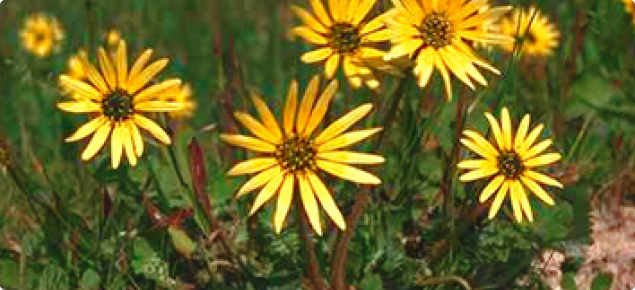Spray graze
This technique involves applying a low rate of hormone herbicide to clover and grass pastures then grazing heavily with 4-5 times the normal stocking rate of sheep or goats 7-10 days after spraying. The stocking rate is reduced after most of the weed has been eaten and before overgrazing damages the desirable pasture. The herbicide increases the palatability of broadleaf weeds and reduces their recovery from grazing.
Spray graze herbicides
2,4-D amine, MCPA and 2,4-DB are the most commonly used herbicides. 2,4-D is the cheapest but may cause some damage to clovers and should only be applied after the clover has at least eight leaves. MCPA is less damaging and can be applied from the three leaf stage of the clover. 2,4-DB is the most expensive but also the least damaging to clover and can be applied from the one leaf stage. It is usually used where high levels of selectivity are required such as when a new variety has been planted, feed is scarce or the paddock is to be harvested for seed.
Spray graze weeds
- Capeweed, Paterson's curse, storksbill (corkscrews and Erodium species) and slender or sheep thistle are effectively controlled by spray grazing at low rates. Typically rates of 500mL/ha of 2,4-D amine625 after the eight leaf stage of the clover, 1L/ha MPCA amine500 after the three leaf stage of the clover or 2L/ha 2,4-DB after the one leaf stage of the clover would be applied.
- Doublegee, variegated thistle, dock and sorrel seedlings, saffron thistle and spear thistle require about double the rates of herbicide above. Some curling of the clover leaves is normal and some loss of production or clover plants may occur, especially with 2,4-D amine at the higher rates.
- Old man dock and established sorrel are not reliably controlled by spray grazing.
- There can be some trade off between the herbicide rate and the stocking pressure after spraying. If it is only possible to use the normal stocking rate after spraying then the quantity of herbicide can be doubled to compensate for this. Similarly if cows are used as the grazing animal then higher rates are required. Increasing the rates of 2,4-D amine beyond 2L/ha is likely to lead to significant clover damage.
- Adjuvants are generally not used with 2,4-D and MCPA as they decrease the selectivity which may increase the clover damage.
- Spraying early in the season usually results in better weed control than later sprays.
- Spraying after budding of the clover will probably result in a decrease of clover seed set.
- In most cases an insecticide such as 100mL/ha of dimethoate can be applied as a tank mix to control lucerne flea and redlegged earth mites that may transfer from the dying weeds to the clover.
- Medics, lucerne and serradella should only be spray grazed with 2,4-DB because 2,4-D and MCPA normally cause unacceptable damage.
- Toxic plants may become more palatable after spray grazing and occasionally nitrate toxicity can occur where plants have been growing in high nitrogen conditions.
The spray graze technique can also be used for declared weeds and information on spray grazing declared plants can be found here.
Information on pasture nutrition, grazing annual pasture, grazing at the break of the season and a deferred grazing calculator can be found through these links or through the See Also links.

